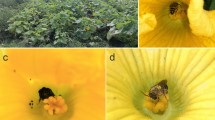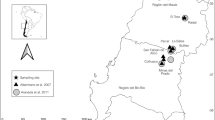Abstract.
We studied an isolated population of Campanula rapunculus and two oligolectic bee species of Chelostoma (Megachilidae), their main pollinators. The population of C. rapunculus consisted of 2808 plants. Measurements of pollen flow showed that 3.7% of the pollen produced by a flower contribute to pollination, 95.5% was collected by bees for their offspring and 0.8% remained on the styles. Pollen analyses of brood cells of Chelostoma rapunculi revealed that females collected on average 4.9 million Campanula pollen to rear one bee. We calculated that approximately 1588 bees of this species could have been reared at the study site during the studied season. The amount of potentially viable pollen deposited on stigmas was 3.6 to 10.7 times higher than the number of ovules. We discuss morphological features of the flowers which may lower the pollen removal rate per bee visit and consequently cause a high visitation and pollination rate.
Similar content being viewed by others
Author information
Authors and Affiliations
Corresponding author
Additional information
The study was supported by a joint project CAPES / DAAD (Probral 112/00). We thank NaBu (Naturschutzbund) Bonn and the Untere Landschaftsbehörde Siegburg for the permission to work at the Natural Reserve Dünstekoven.
Rights and permissions
About this article
Cite this article
Schlindwein, C., Wittmann, D., Martins, C. et al. Pollination of Campanula rapunculus L. (Campanulaceae): How much pollen flows into pollination and into reproduction of oligolectic pollinators?. Plant Syst. Evol. 250, 147–156 (2005). https://doi.org/10.1007/s00606-004-0246-8
Received:
Accepted:
Published:
Issue Date:
DOI: https://doi.org/10.1007/s00606-004-0246-8




